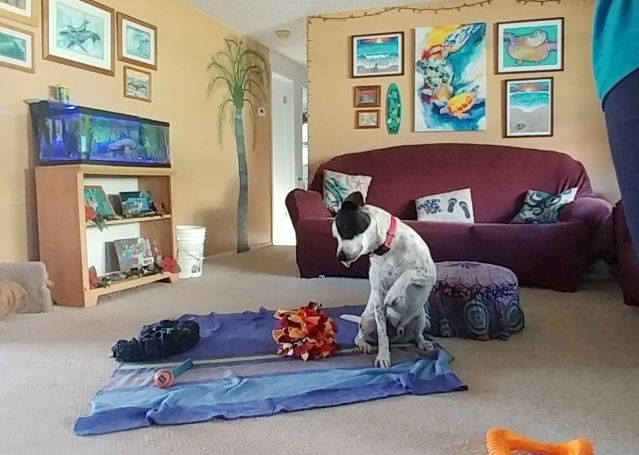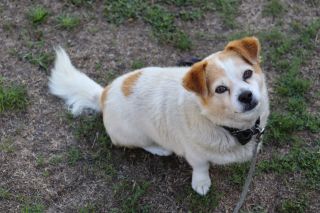Creativity
Dogs Demonstrate Creativity, Too
Pet dogs succeeded in a creativity test used with marine mammals.
Posted February 9, 2023 Reviewed by Lybi Ma
Key points
- Researchers used citizen science to investigate creativity in pet dogs.
- Owners trained their dogs on the “create” behavior, in which the dog must produce a behavior not previously performed.
- Dogs performed similarly to dolphins in the ability to be creative. There were individual differences in dogs’ flexibility and originality.
_(1).jpg?itok=j39VI_ra)
Dogs possess the ability to be creative, according to a new study. Pet dogs performed similarly to dolphins when asked to creatively come up with a new behavior, adding to the growing literature on dog cognition.
How do you get an animal to demonstrate creativity? Marine mammal trainers have been doing it for decades. Dolphins can be taught to produce a novel behavior on command: Upon seeing the “create” cue (often a trainer’s hand gesture), the dolphin is rewarded if it does something new—a behavior not performed in the session previously.
Elaina Franklin, the coauthor of the new study, had previously trained the create behavior in dolphins. Then she decided to train her dog, Frankie, to perform the behavior. Once Frankie was successful at grasping the concept, Franklin teamed with Eckerd College psychologist Lauren Highfill to empirically study the behavior in dogs.
The researchers used citizen science to gather data, recruiting trainers and their dogs and staying connected via a Facebook group page.
“The Facebook group was definitely a helpful tool for both researchers and participants,” says coauthor Kaitlyn Willgohs, then an undergraduate at Eckerd College.

The researchers used the page to provide the dog owners with a step-by-step training video for the create behavior. The owners filmed their sessions and posted them in the group for coding.
To fulfill the criteria of the create behavior, the dog needed to perform a behavior not already performed in the training session. The researchers measured the dogs’ performances for three components of creativity: fluency (did the dog perform a non-repeated behavior or not), flexibility (was the behavior high energy or low energy), and originality (was the behavior something out of their training repertoire or was it completely novel).
You can watch Frankie participate in a training session here.
Creative Canines
All five dogs in the study performed significantly more non-repeated behaviors over the course of their trials, suggesting that they understood the concept of the create behavior cue. The results show that dogs possess the ability to remember which behaviors they had already produced, much like the marine mammals in previous studies.
Individual dogs varied when it came to the energy level and novelty of their creative behaviors. For instance, all but one dog performed more lower-energy behaviors than high-energy behaviors. The outlier, a border collie named Surfer, performed a nearly equal number of low- and high-energy behaviors. Willgohs says this could represent variation between breeds and warrants further research. It’s also interesting because, in previous studies with dolphins, the animals performed more low-energy behaviors than high-energy behaviors.

Overall, the differences between dogs in repetition, energy, and novelty show that individuals may possess different capacities for creativity.
The study is one of few examining animals’ memory of internal stimuli (like their own actions) rather than external stimuli (such as remembering a series of objects). Research like this shines a light on what’s going on in the minds of dogs, says Willgohs.
“One of the most interesting aspects of this research is that it gives us some insight into dogs’ capacity to remember their own actions in a short-term memory context, as the criteria for the behavior was that they could not repeat a behavior previously performed,” she says.
Training Creativity
Willgohs says that practically speaking, the study of canine cognition has direct implications for working dogs, including guide dogs, therapy dogs, and detector dogs.
“Dogs, like other animals, can lose motivation when stuck on a complex task,” she says. “We hypothesize that dogs who have been trained on the create behavior might be more persistent when attempting complex tasks and that they might develop creative approaches to solving problems.”
Willgohs says the create behavior is something people can try with their own dogs. “The create cue allows a dog to choose their behavior rather than being told exactly what to do—and giving animals a little choice in their day is always a good thing.
“Understanding the concept that you are being asked to produce a new behavior on cue is complex, so I think it is exciting to scientifically dive into that and see dogs be successful with it. Hopefully, people will read our paper and say ‘Wow! My dog is smarter than I think!’”
References
Willgohs, K. R, Williams, J., Franklin, E., & Highfill, L. E. (2022). The Creative Canine: Investigating the concept of creativity in dogs (Canis lupus familiaris) using citizen science. International Journal of Comparative Psychology, 35.


